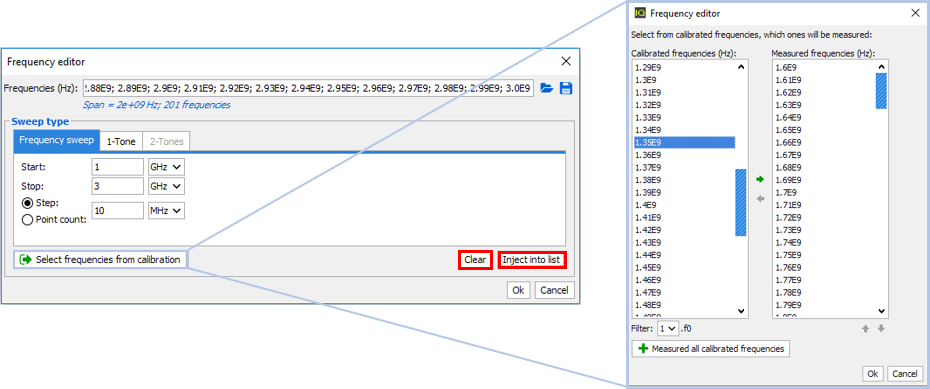2-tones measurement panel: Sweep settings
Sweep setting is used to define two, three or four nested loops sweep in function of power, frequency, 2-tones spacing and VSWR using different acquisition mode.
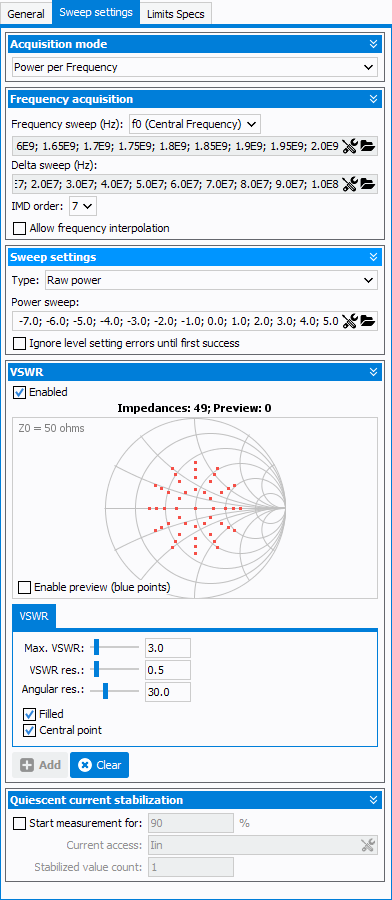
Acquisition Mode:

- Power per Frequency: for each frequency acquisition a ramp of RF power
will be sent to the DUT

- Fast CW is a sweeping method that can be used to improve the measurement speed. Contrary to the classical power sweep where IQSTAR is sweeping the VNA power, the VNA is here asked to sweep the power for a fixed frequency, asking the instruments to bufferize the measured values, and resulting in a great speed improvement.
DANGER: When using this type of sweep, the measurement stop conditions
will not be verified because of the VNA sweeping entire power sweeps. The
DUT will not be under IQSTAR protection and measurement can lead to
damages. It is important to know the limits to not exceed in this
case.
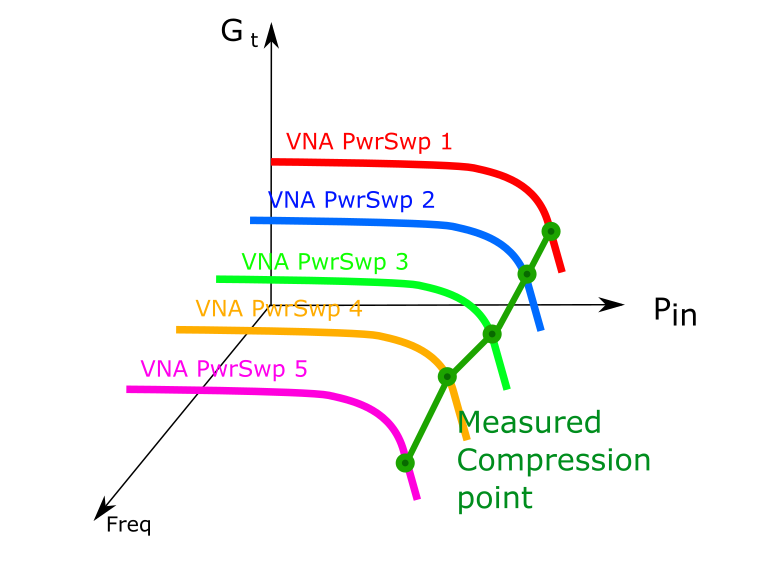
For more informations about how to setup a Fast CW bench, see Getting Started : "Fast CW measurements".
Fequency Sweep Settings:
- Frequency sweep:
- Select the reference frequency for the sweep: Central frequency
(f0, which is (f2+f1)/2) or one of the frequencies of the 2-tones signal
(f1 or f2)
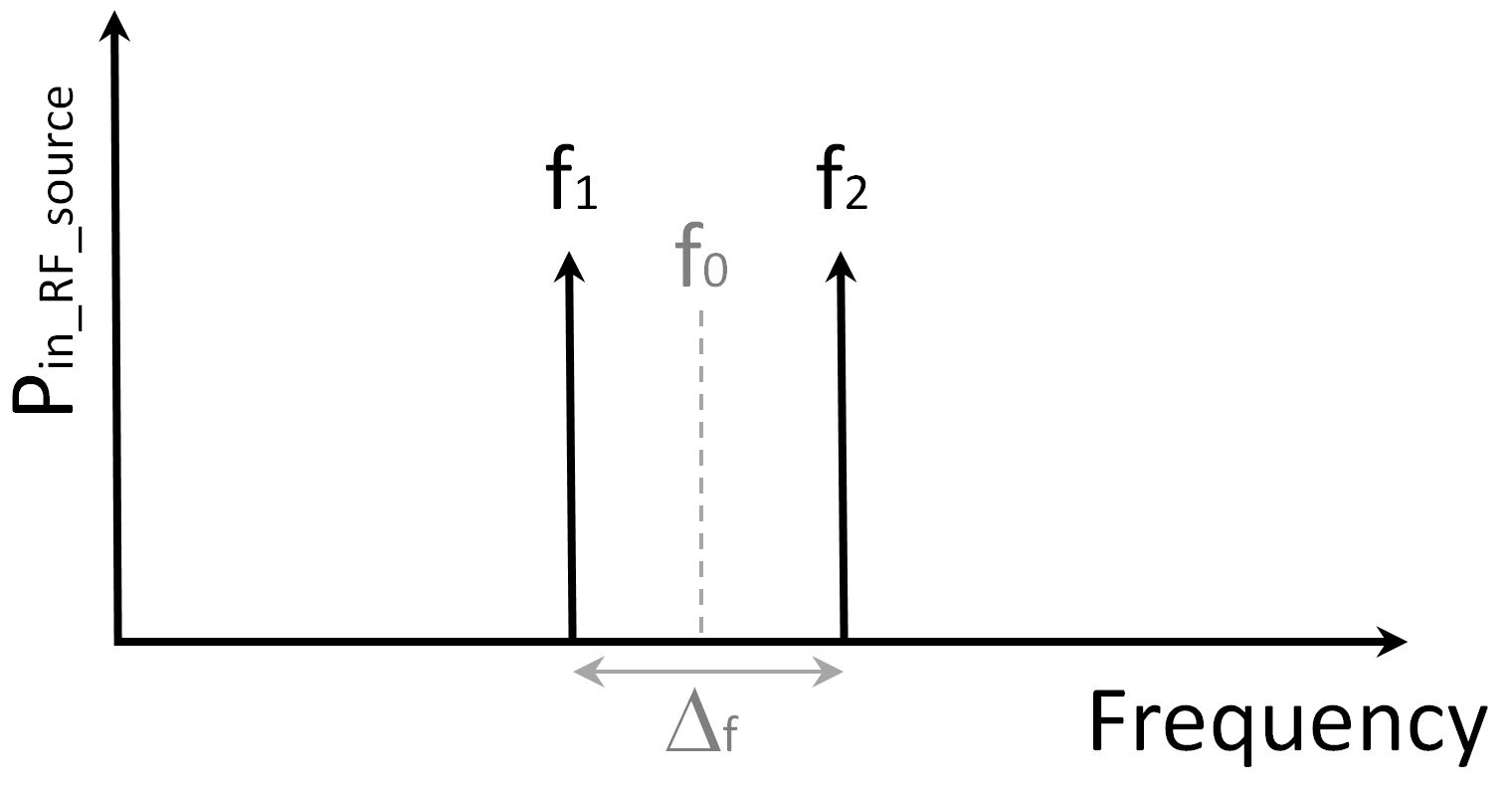
- By default the frequency list is filled with frequencies from the
calibration. Click on
 icon to open the 'Frequency editor' and
modify the frequency listNote: 'Frequency editor' is a tool used to define frequency sweeps or frequency segments. Click on 'Clear' or 'Inject into list' to add or remove frequencies. It is possible to select the frequencies available in the selected calibration file by clicking on 'Select frequencies from calibration'. It's also possible to save or load a frequency list (*.freq files) using
icon to open the 'Frequency editor' and
modify the frequency listNote: 'Frequency editor' is a tool used to define frequency sweeps or frequency segments. Click on 'Clear' or 'Inject into list' to add or remove frequencies. It is possible to select the frequencies available in the selected calibration file by clicking on 'Select frequencies from calibration'. It's also possible to save or load a frequency list (*.freq files) usingicons.
- Select the reference frequency for the sweep: Central frequency
(f0, which is (f2+f1)/2) or one of the frequencies of the 2-tones signal
(f1 or f2)
- Delta sweep:
- Delta value: is the spacing between f1 and f2. Use
 icon to
modify the list of delta sweep
icon to
modify the list of delta sweep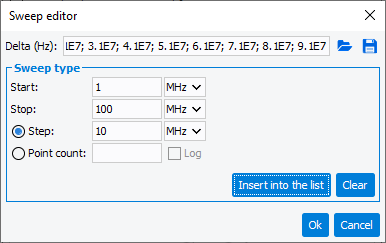
- IMD order: select the IMD order to record (from 3 to 9)
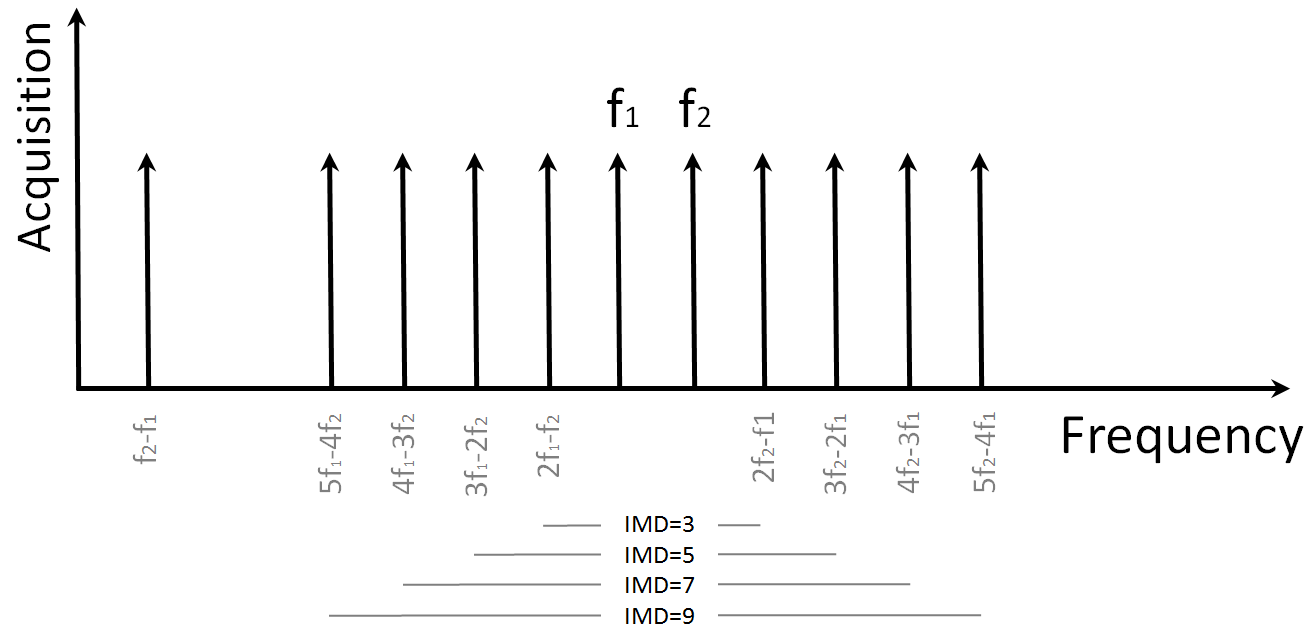
- Delta value: is the spacing between f1 and f2. Use
- Allow frequency interpolation: if the list of RF stimulus frequencies is different from the calibrated one, IQSTAR will interpolate the errors terms
Power Sweep Settings
Sweep settings configurations depend on the acquisition mode selected:
- Type: the power sweep can be of different types:
- Raw power: Total raw power. IQSTAR will divide the value by two
(in Watts) in order to send the command to both RF source
(Ptotalraw=PrawSRC1+PrawSRC2)Note: If Driver Amplifier is defined in the schematic, the power defined will take into account the driver amplifier offset set in the schematic.
- Raw power (calibrated): Total raw power calibrated. Available if the Raw Power Calibration has been performed. There is no optimization but the power is offsetted from the Raw Power Calibration coefficients
- Total available input power: the total available power is optimized at the input of the DUT (Pin_avs_total=Pin_avs_@f1+Pin_avs_@f2)
- Total delivered input power: the total delivered power is optimized at the input of the DUT (Pin_del_total=Pin_del_@f1+Pin_del_@f2)
- Total output power: the total output power is optimized at the output of the DUT (Pout_total=Pout_@f1+Pout_@f2)
- Raw power: Total raw power. IQSTAR will divide the value by two
(in Watts) in order to send the command to both RF source
(Ptotalraw=PrawSRC1+PrawSRC2)
- Ignore level setting errors until first success: if there is a power optimization IQSTAR moves to next power level if the optimisation does not reach the previous target
Note: It is important to note that input powers at f1 and f2 are balanced in order
to compensate for the dispersive effects of external passive components or
driver amplifiers. IQSTAR embeds its own 2-tones optimizer and the tolerance and
number of iterations can be configured in the schematic main option.
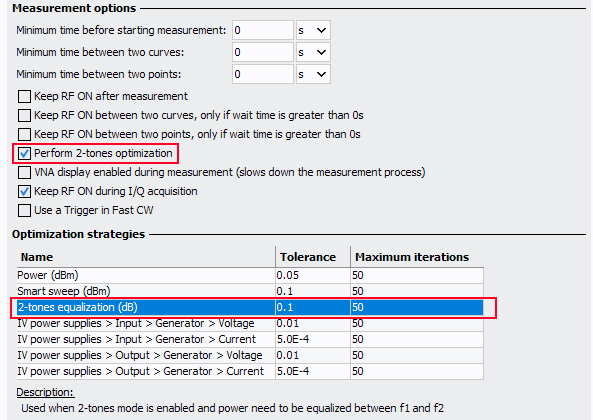
From this panel, select whether the 2 tones have to be balanced and what is the
'Maximum iterations' of this optimization and the acceptable tolerance (with f1 as
the reference):
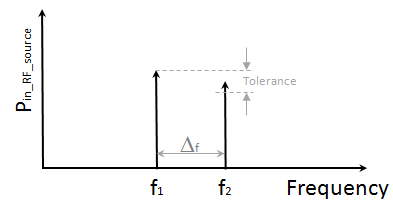

VSWR
In order to affect on purpose the DUT, it is possible to control a load tuner and change the load impedance of the DUT. The pattern consists of impedance points that are 50-Ohms centered. If this VSWR module is enabled, the tuner will be initialized before the measurement begins.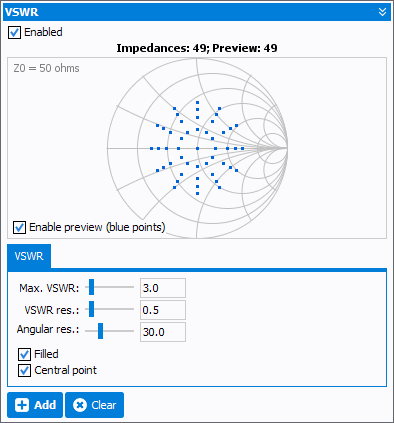
- Enable preview (blue points):set active the preview in the smith chart. Red points are already added, blue are the current ones being set up.
- Max VSWR: pattern max VSWR
- VSWR res.: pattern VSWR resolution
- Angular res.: pattern VSWR angular resolution
- Filled: if check, the pattern is filled with points distance of VSWR resolution value. If unchecked only the circumference points will be active.
- Central point: activates the 50 Ohms point if checked.
Important: Once the pattern is created, the ADD button needs to be
pressed to turn them into red and use them during the measurements. The CLEAR
button can be used to empty the pattern.
Fast CW settings (Available with Fast CW only):
When fast power sweeps are needed and the device is know well enough (Stop conditions
ignored in this mode), the Fast CW mode can be used.
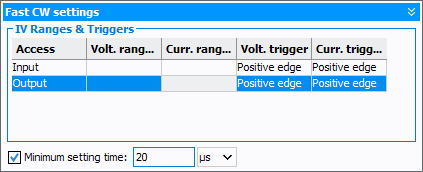
If the used IV multimeters are compatible with burst measurements, instrument measurement ranges will need to be selected in this table. If some instruments do not have this burst capability, please refer to DC Measurement. Triggers also needs to be defined and are positive edge by default.

If the used IV multimeters are compatible with burst measurements, instrument measurement ranges will need to be selected in this table. If some instruments do not have this burst capability, please refer to DC Measurement. Triggers also needs to be defined and are positive edge by default.
If an instrument has no burst capability, the following message should
appear:


Minimum setting time: sets a delay between the VNA power sweep points. Can be used to achieve a DUT steady state before measuring a value.
Quiescent current stabilization (Available with Power per Frequency, Smart and Fast measurements):
When the DUT’s hysteresis, thermal or trapping effects are present, it is
recommended to sweep 'Frequency per Power' rather than 'Power per Frequency' or add
dwell time to minimize the effects from previous measurements. IQSTAR includes the
'Quiescent current stabilization' feature in order to monitor the quiescent current
in function of time between each power sweep. Therefore, an appropriate dwell time
will be automatically defined between each power sweep. The aim is to define a
tolerance on the quiescent current to achieve before starting a new power
sweep.

- Start measurement for: set the level (in % of initial value) of quiescent current to be reached before a new sweep can start
- Current access: choose the current access to apply the conditionNote: It is also possible to create an expression in order to define a custom current (e.g. sum of two currents).
- Stabilized value count: set the number of consecutive measurements that
must be within the toleranceWhen 'Quiescent current stabilisation' is enabled. An additional window will pop up during measurements to display the quiescent current value, the reference current level and the current tolerance. This curve can then be saved in a file if needed.
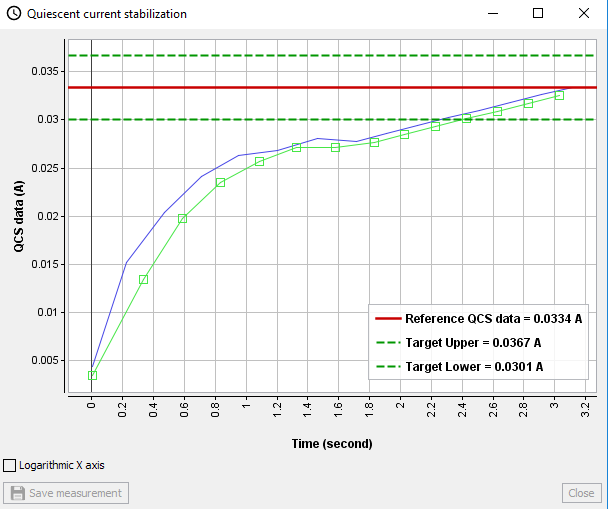
Related Information:

